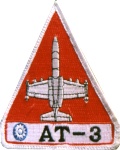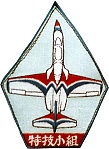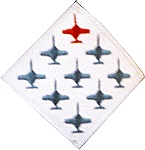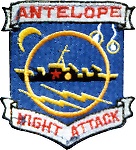 In March 1975, the AIDC began a study of an advanced jet trainer to replace the aging
T-33A. The program gained its momentum on December 15, 1975, when the AIDC
signed an agreement with Northrop to co-develop a single-engine jet trainer; the
prototype was designated XAT-3. The change from the original single-engine layout to
the current twin-engine design was approved by the Ministry of National Defense on
June 13, 1976. Two prototype aircraft were built. The first prototype 0801 (69-6001) first
took off on September 16, 1980. The second prototype 0802 (71-6002) first flew on
October 30, 1981. The first production example, re-designated AT-3, 0803, was rolled
out in an official ceremony on March 1, 1984. To boost morale, the aircraft was named
Tzu Chiang, meaning in Chinese gaining strength without relying on others. It had
made its first flight on February 6, 1984. Delivery began in March 1984, completed in
1990. More than sixty AT-3s were ordered. There was also a single-seat dedicated
attack version, designated A-3, but its program was cancelled after two prototype
A-3s (0901, 0902) were built.
In March 1975, the AIDC began a study of an advanced jet trainer to replace the aging
T-33A. The program gained its momentum on December 15, 1975, when the AIDC
signed an agreement with Northrop to co-develop a single-engine jet trainer; the
prototype was designated XAT-3. The change from the original single-engine layout to
the current twin-engine design was approved by the Ministry of National Defense on
June 13, 1976. Two prototype aircraft were built. The first prototype 0801 (69-6001) first
took off on September 16, 1980. The second prototype 0802 (71-6002) first flew on
October 30, 1981. The first production example, re-designated AT-3, 0803, was rolled
out in an official ceremony on March 1, 1984. To boost morale, the aircraft was named
Tzu Chiang, meaning in Chinese gaining strength without relying on others. It had
made its first flight on February 6, 1984. Delivery began in March 1984, completed in
1990. More than sixty AT-3s were ordered. There was also a single-seat dedicated
attack version, designated A-3, but its program was cancelled after two prototype
A-3s (0901, 0902) were built.
There are two zero/zero Martin-Baker 10 ejection seats in the dual-control cockpit of
production models. The ejection seats on the prototype were of Northrop design. The
crew of two sit in tandem, with the rear seat elevated 30 cm. All AT-3s use MDC
systems to break the canopy in emergency. Basic construction is metal but with
laminated graphite composite airbrake panels and metal honeycomb core ailerons.
The two prototypes 0801 and 0802 were equipped with unspecified interim engines.
Published photographs showed the tailpipes protruded from the engine nacelles. The
power plant for production models was changed to two Garrett TFE731-2-2L
non-afterburning turbofan engines, producing a total thrust of 3178 kg (31.1 kN; 7000
lb). The maximum external load is 2721 kg (6000 lb). AT-3s have five hardpoints (one
centerline, two inboard underwing, two outboard underwing) and wingtip launch rails.
Weapons that have been seen carried by the AT-3 include Mk 82 500 lb bombs, Mk
20 cluster bombs, 5 in and 2.75 in rocket pods, 20 mm gun pods, and heat-seeking
air-to-air missiles including the AIM-9 and the Tien Chien (Sky Sword) 1 developed by
the CSIST.
Service History
The first AT-3 operator is the Flight Training Command in ROCAF Academy,
which has bee flying the aircraft since 1986.
After student pilots complete basic training in the T-34C, those who choose the Fighter
track proceed to fly the AT-3 for 110 flying hours.
Early ROCAF Academy AT-3 were overall bare-metal with the nose section, wing-tips, and the vertical
stabilizer painted in fluorescent orange.
After the Thunder Tiger Demonstration Team converted to the AT-3 (
described next), all ROCAF Academy AT-3 also adopted the painting
scheme used by Thunder Tiger's AT-3.

 In 1988, the ROCAF General Headquarters designated the ROCAF Academy to
take over the public aerial demonstration duty from the Thunder Tiger Demonstration Team,
a task force that had been formed by volunteer pilots from the 443rd TFW at Tainan since 1954.
the new team members were drawn from the pool of instructor pilots at the Academy
and trained by the Thunder Tiger.
The equipment was also changed from the F-5E to the AT-3 at the same time.
In the early days of the AT-3 era, the aerobatic team did not adopt the legendary name
Thunder Tiger, but simply called itselt the Aerobatic Team.
However, Thunder Tiger had stuck in all aviation fans' minds and the team renamed itself
Thunder Tiger in 1990.
In 1988, the ROCAF General Headquarters designated the ROCAF Academy to
take over the public aerial demonstration duty from the Thunder Tiger Demonstration Team,
a task force that had been formed by volunteer pilots from the 443rd TFW at Tainan since 1954.
the new team members were drawn from the pool of instructor pilots at the Academy
and trained by the Thunder Tiger.
The equipment was also changed from the F-5E to the AT-3 at the same time.
In the early days of the AT-3 era, the aerobatic team did not adopt the legendary name
Thunder Tiger, but simply called itselt the Aerobatic Team.
However, Thunder Tiger had stuck in all aviation fans' minds and the team renamed itself
Thunder Tiger in 1990.
Unlike their predecessors, all performing AT-3 were all were painted in a vivid blue-white-red scheme.
This paint scheme was soon adopted by the entire AT-3 fleet at the Air Force Academy,
making it virtually impossible to distinguish between them.
This does not imply any AT-3 can be used for demonstration, though.
The Thunder Tiger AT-3 carry an oil tank inside the gun bay.
The oil is ducted by an external pipe fitted under the fuselage to the
outlet behind the port-side jet pipe to generate the smoke.
The AT-3 demonstration team made its public performance on March 27, 1989, flying six aircraft.
Unlike the USAF Thunderbirds, which announces the performance times and locations well in
advance every year, the Thunder Tiger usually releases its schedule only weeks,
sometimes even days, before the first performance of the year.
Even the number of aircraft used does not seem to be fixed.
Most of the time, six AT-3 would perform in a show, with six flying formations and the other two solos.
But there had times when only five aircraft flew. Sometimes as many as seven aircraft could be seen.
 On September 9, 1989, the 35th Combat Squadron at CCK traded its vintage T-33A with
twenty AT-3 and its role was designated as Night Attack.
The legendary 35th Squadron used to operate the U-2 until late 1974, when it was deactivated.
It stood up again on June 16, 1977, in the form of the 35th Combat Squadron.
The squadron logo was also changed from the famous "Black Cat" to the "Antelope."
The re-established 35th Squadron were assigned the armed version of T-33A retired from the ROCAF Academy.
These T-33A had twin 12.7-mm machine guns fitted in the nose and could carry rocket or gun pods under
the wings.
Then based at Ching Chuan Kang, the 35th reported directly to the 427th Tactical Fighter Wing.
On September 9, 1989, the 35th Combat Squadron at CCK traded its vintage T-33A with
twenty AT-3 and its role was designated as Night Attack.
The legendary 35th Squadron used to operate the U-2 until late 1974, when it was deactivated.
It stood up again on June 16, 1977, in the form of the 35th Combat Squadron.
The squadron logo was also changed from the famous "Black Cat" to the "Antelope."
The re-established 35th Squadron were assigned the armed version of T-33A retired from the ROCAF Academy.
These T-33A had twin 12.7-mm machine guns fitted in the nose and could carry rocket or gun pods under
the wings.
Then based at Ching Chuan Kang, the 35th reported directly to the 427th Tactical Fighter Wing.
These AT-3 were painted in a Vietnam-style three-tone camouflage and were initially fitted with
semi-recessed twin 12.7-mm machine guns, which were believed to be "recycled" from the retired T-33A,
in the underside gun bays.
Since April 1991, the machine guns had been all removed from AT-3 of the 35th and wingtip missile
launch rails began to appear.
Now that the 35th Squadron AT-3 were operated at higher speed than were their brothers at t
he Academy, their fuel consumption rate was also higher.
As a consequence, aircraft flying operational sorties usually carried two underwing fuel tanks,
extending theloitering time from 45 minutes to 70.
As its name indicates, the 35th Squadron conducted its missions mainly at night.
Without advanced EO or radar systems onboard, the tactics adopted by the 35th's AT-3 were
very low-tech.
Each attack package was made up of two AT-3.
The leading aircraft would locate the target and then drop illuminating flares.
The following AT-3 subsequently made its attack run.
In late 1991, the 35th began to apply the Antelope logo to the tails of AT-3.
On July 1, 1992, the 35th Squadron was relocated to Hsinchu.
Since September 1995, it has been operating out of Kangshan,
sharing the AT-3 maintenance facilities at the Air Force Academy.
On February 28, 1999, the 35th Squadron stood down again.
All aircraft were absorbed by the Air Force Academy and repainted in the standard blue-while-red scheme.
AT-3's manufacturer, AIDC, retained the two A-3 prototypes and a single AT-3.
A-3 0901 has mainly been used for contract target-towing missions while
A-3 0902 and AT-3 0825 have been heavily modified.
Modifications include the addition of the APG-66T radar and the fire control system for the
Hsiung Feng (Strong Wind) 2 anti-ship missiles,
two multi-function displays (MFDs) on both sides of the front panel,
a head-up display (HUD) with up-front controls,
the hands-on-throttle-and-stick (HOTAS) control.
0825 is unofficially designated as the AT-3B.
Fleet Images
Fleet Information
|
AT-3
| Tail No. |
Serial No. |
Remark |
| 0801 |
69-6001 |
|
| 0802 |
71-6002 |
|
| 0803 |
73-6003 |
|
| 0804 |
73-6004 |
crashed 10/14/92; 2 killed |
| 0805 |
7?-6005 |
crashed 06/12/95; 2 seriously injured |
| 0806 |
74-6006 |
|
| 0807 |
74-6007 |
|
| 0808 |
74-6008 |
|
| 0809 |
74-6009 |
|
| 0810 |
74-6010 |
|
| 0811 |
75-6011 |
|
| 0812 |
75-6012 |
|
| 0813 |
75-6013 |
|
| 0814 |
75-6014 |
|
| 0815 |
75-6015 |
|
| 0816 |
75-6016 |
|
| 0817 |
75-6017 |
|
| 0818 |
75-6018 |
|
| 0819 |
75-6019 |
|
| 0820 |
75-6020 |
|
| 0821 |
75-6021 |
|
| 0822 |
75-6022 |
|
| 0823 |
75-6023 |
|
| 0824 |
75-6024 |
|
| 0825 |
75-6025 |
|
| 0826 |
75-6026 |
crashed 09/04/98; one ok |
| 0827 |
75-6027 |
crashed 06/11/03; two killed |
| 0828 |
75-6028 |
|
| 0829 |
7?-6029 |
|
| 0830 |
7?-6030 |
|
| 0831 |
7?-6031 |
crashed 04/23/91; two ok |
| 0832 |
76-6032 |
|
|
| Tail No. |
Serial No. |
Remark |
| 0833 |
76-6033 |
crashed 06/27/97; one killed |
| 0834 |
76-6034 |
|
| 0835 |
76-6035 |
|
| 0836 |
76-6036 |
|
| 0837 |
76-6037 |
|
| 0838 |
76-6038 |
|
| 0839 |
76-6039 |
|
| 0840 |
76-6040 |
|
| 0841 |
76-6041 |
|
| 0842 |
76-6042 |
|
| 0843 |
76-6043 |
crashed 02/28/96; one ok |
| 0844 |
76-6044 |
|
| 0845 |
76-6045 |
|
| 0846 |
76-6046 |
|
| 0847 |
76-6047 |
|
| 0848 |
76-6048 |
|
| 0849 |
76-6049 |
|
| 0850 |
76-6050 |
crashed 01/26/94; one killed, one ok |
| 0851 |
76-6051 |
|
| 0852 |
77-6052 |
|
| 0853 |
77-6053 |
|
| 0854 |
77-6054 |
|
| 0855 |
77-6055 |
|
| 0856 |
77-6056 |
|
| 0857 |
77-6057 |
|
| 0858 |
77-6058 |
crashed 11/07/94; two ok |
| 0859 |
77-6059 |
|
| 0860 |
78-6060 |
|
| 0861 |
78-6061 |
|
| 0862 |
78-6062 |
|
| 0863 |
78-6063 |
|
|
|
XA-3
| Tail No. |
Serial No. |
Remark |
| 0901 |
71-7001 |
|
| 0902 |
71-7002 |
|
|

